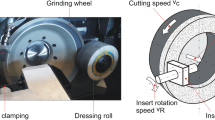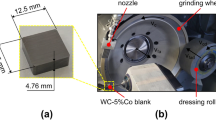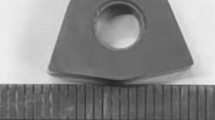Abstract
Based on the analysis of the ground surface, grinding forces, and energy, this paper brings a comprehensive approach to determine the effects of different process parameters (cutting and feed speeds, dressing feed speed, abrasive grain size, and grinding wheel bonding material) on the inducement of residual stresses in cemented tungsten carbide cutting inserts finished by plunge-face grinding. The obtained results demonstrated that compressive residual stresses of higher magnitude are mainly observed in the direction perpendicular to the abrasive grain path and can be achieved by the application of vitrified bonded grinding wheels with coarser abrasive grains.









Similar content being viewed by others
Data availability
Not applicable.
References
Klocke F, Wirtz C, Mueller S, Mattfeld P (2016) Analysis of the material behavior of cemented carbides (WC-Co) in grinding by single grain cutting tests. Proc CIRP 46:209–213. https://doi.org/10.1016/j.procir.2016.03.209
Bifano TG, Fawcett SC (1991) Specific grinding energy as an in-process control variable for ductile-regime grinding. Precis Eng 13:256–262. https://doi.org/10.1016/0141-6359(91)90003-2
Zelwer O, Malkin S (1980) Grinding of WC-Co cemented carbides. J Eng Ind 102:209–220. https://doi.org/10.4028/www.scientific.net/AMR.1017.573
Ren YH, Zhang B, Zhou ZX (2009) Specific energy in grinding of tungsten carbides of various grain sizes. CIRP Ann Manuf Technol 58:299–302. https://doi.org/10.1016/j.cirp.2009.03.026
Larsen-Basse J (1985) Binder extrusion in sliding wear of WC-Co alloys. Wear 105:247–256. https://doi.org/10.1016/0043-1648(85)90071-7
Sarin VK, Johannesson T (1975) On the deformation of WC-Co cemented carbides. Metal Sci 9:472–476. https://doi.org/10.1179/030634575790444531
Rettenmayr M, Exner HE, Mader W (1988) Electron microscopy of binder phase deformation in WC-Co alloys. Mater Sci Technol 4:984–990. https://doi.org/10.1179/mst.1988.4.11.984
Yang J, Roa JJ, Schwind M, Odén M, Johansson-Jõesaar MP, Llanes L (2017) Grinding-induced metallurgical alterations in the binder phase of WC-Co cemented carbides. Mater Charact 134:302–310. https://doi.org/10.1016/j.matchar.2017.11.004
Zuñega JCP, Gee M, Wood RJK, Walker J (2012) Scratch testing of WC/Co hardmetals. Tribol Int 54:77–86. https://doi.org/10.1016/j.triboint.2012.02.027
Johnson-Walls D, Evans AG, Marshall DB, James MR (1986) Residual stresses in machined ceramic surfaces. J Am Ceram Soc 69:44–47. https://doi.org/10.1111/j.1151-2916.1986.tb04691.x
Yang J, Odén M, Johansson-Jõesaar MP, Llanes L (2014) Grinding effects on surface integrity and mechanical strength of WC-Co cemented carbides. Proc CIRP 13:257–263. https://doi.org/10.1016/j.procir.2014.04.044
Brinksmeier E, Cammett JT, König W, Leskovar P, Peters J, Tönshoff HK (1982) Residual stresses – Measurement and causes in machining processes. CIRP Ann 31:491–510. https://doi.org/10.1016/S0007-8506(07)60172-3
Hegeman JBJW, De Hosson JTM, With G (2001) Grinding of WC-Co hardmetals. Wear 248:187–196. https://doi.org/10.1016/S0043-1648(00)00561-5
Jiang D, Anné G, Vleugels J, Vanmeensel K, Eeraerts W, Liu W, Lauwers B, Biest OV (2005) Residual stresses in hardmetals caused by grinding and EDM machining and their influence on the flexural strength. Powder Metall High Perform Mater 2:1075–1085
Zhao X (2010) WC-Co tool failure analysis and the grinding effect study. Adv Mater Res 139–141:269–273. https://doi.org/10.4028/www.scientific.net/AMR.139-141.269
Gladkikh LI, Sverdlova BM, Fuks MY (1968) Residual stresses in surface layers of carbide tool tips after diamond grinding. Fiz-Khim Mekh Mater 4:697–702. https://doi.org/10.1007/BF00721676
Liu X, Zhang B (2002) Effects of grinding process on residual stresses in nanostructured ceramic coatings. J Mater Sci 37:3229–3239. https://doi.org/10.1023/A:1016174731658
Zoei MS, Sadeghi MH, Salehi M (2016) Effect of grinding parameters on the wear resistance and residual stress of HVOF-deposited WC-10Co-4Cr coating. Surf Coat Technol 307:886–891. https://doi.org/10.1016/j.surfcoat.2016.09.067
Masoumi H, Safavi SM, Salehi M, Nahvi SM (2014) Effect of grinding on the residual stress and adhesion strength of HVOF thermally sprayed WC-10Co-4Cr coating. Mater Manuf Process 29:1139–1151. https://doi.org/10.1080/10426914.2014.930893
Mao C, Liang C, Zhang Y, Zhang M, Hu Y, Bi Z (2017) Grinding characteristics of cBN-WC-10Co composites. Ceram Int 43:16539–16547. https://doi.org/10.1016/j.ceramint.2017.09.040
Takeyama H, Iijima N, Uno K (1982) Surface integrity of cemented carbide tool and its brittle fracture. CIRP Ann Manuf Technol 31:59–63. https://doi.org/10.1016/S0007-8506(07)63269-7
Withers PJ, Bhadeshia HKDH (2001) Residual stress part 1 – Measurement techniques. Mater Sci Technol 17:355–365. https://doi.org/10.1179/026708301101509980
Denkena B, Köhler J, Ventura CEH (2013) Customized cutting edge preparation by means of grinding. Precis Eng 37:590–598. https://doi.org/10.1016/j.precisioneng.2013.01.004
Cruz DC, Sordi VL, Ventura CEH (2020) Surface analysis of WC-5%Co cemented tungsten carbide cutting insert after plunge-face grinding. Int J Adv Manuf Technol 108:323–330. https://doi.org/10.1007/s00170-020-05382-y
Klocke F (2011) Manufacturing Processes 1: Cutting. Springer-Verlag, Berlin
Team RS (2020) RS studio: integrated development environment for R. http://www.rstudio.com. Accessed 2 July 2020
Grömping U (2014) R package FrF2 for creating and analyzing fractional factorial 2-level designs. J Stat Softw 56:1–56. https://doi.org/10.18637/jss.v056.i01
Lenth RV (2009) Response-surface methods in R, using RSM. J Stat Softw 32:1–17. https://doi.org/10.18637/jss.v032.i07
Wickham H (2016) ggplot2: Elegant graphics for data analysis. Springer-Verlag, New York
Klocke F (2009) Manufacturing processes 2: grinding, honing, lapping. Springer-Verlag, Berlin
Tönshoff HK, Denkena B (2013) Basics of cutting and abrasive processes. Springer-Verlag, Berlin
Denkena B, Köhler J, Ventura CEH (2014) Influence of grinding parameters on the quality of high content PCBN cutting inserts. J Mater Process Technol 214:276–284. https://doi.org/10.1016/j.jmatprotec.2013.09.013
Jaensson BO (1971) Residual stresses and stress-strain behaviour of the WC-Co composite material. Mater Sci Eng 8:41–53. https://doi.org/10.1016/0025-5416(71)90041-3
Zahedi A, Tawakoli T, Akbari J, Azarhoushang B (2014) Conditioning of vitrified bond CBN grinding wheels using a picosecond laser. Adv Mater Res 1017:573–579. https://doi.org/10.4028/www.scientific.net/AMR.1017.573
US Army Industrial Engineering Activity (1991) Plastic matrix composites with continuous fiber reinforcement. Military Handbook. US Department of Defense. https://apps.dtic.mil/dtic/tr/fulltext/u2/a307849.pdf. Accessed 17 Jun 2020
Acknowledgements
The authors would like to thank the Federal University of West Bahia (UFOB) and the Federal University of São Carlos, Graduate Program in Materials Science and Engineering, for supporting this research. This study was financed in part by the Coordenação de Aperfeiçoamento de Pessoal de Nível Superior–Brasil (CAPES)–Finance Code 001. The São Paulo Research Foundation (FAPESP) is also gratefully acknowledged for financial support (grant numbers 2015/15622-2, 2017/12309-7, and 2017/12304-5) and the Brazilian Nanotechnology National Laboratory is acknowledged for providing residual stress measurements.
Funding
This work was financed in part by the Coordenação de Aperfeiçoamento de Pessoal de Nível Superior–Brasil (CAPES)–Finance Code 001 and was financially supported by the São Paulo Research Foundation (FAPESP) (grant numbers 2015/15622-2, 2017/12309-7, and 2017/12304-5).
Author information
Authors and Affiliations
Contributions
Not applicable.
Corresponding author
Ethics declarations
Conflict of interest
The authors declare that they have no conflict of interest.
Code availability
Not applicable.
Additional information
Publisher’s note
Springer Nature remains neutral with regard to jurisdictional claims in published maps and institutional affiliations.
Rights and permissions
About this article
Cite this article
Cruz, D.C., Christoforo, A.L., Sordi, V.L. et al. Inducement of residual stresses in WC-5%Co cutting inserts by plunge-face grinding. Int J Adv Manuf Technol 113, 553–563 (2021). https://doi.org/10.1007/s00170-020-06583-1
Received:
Accepted:
Published:
Issue Date:
DOI: https://doi.org/10.1007/s00170-020-06583-1




